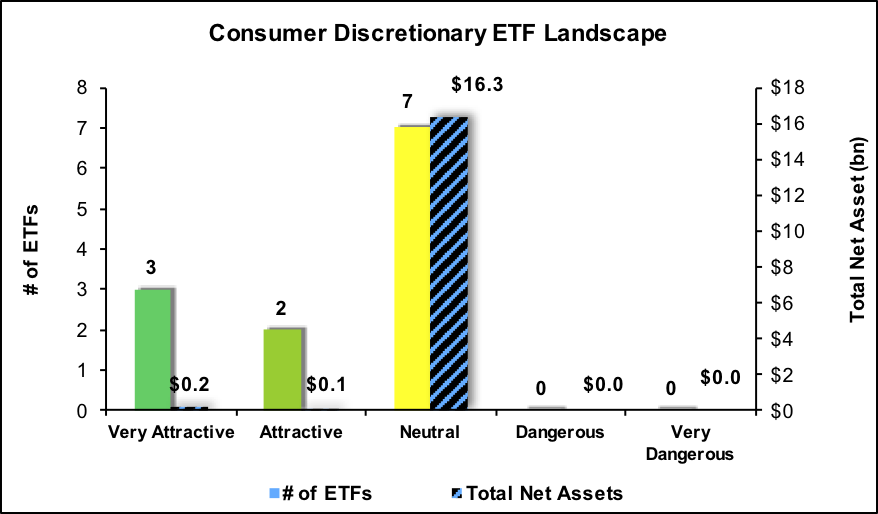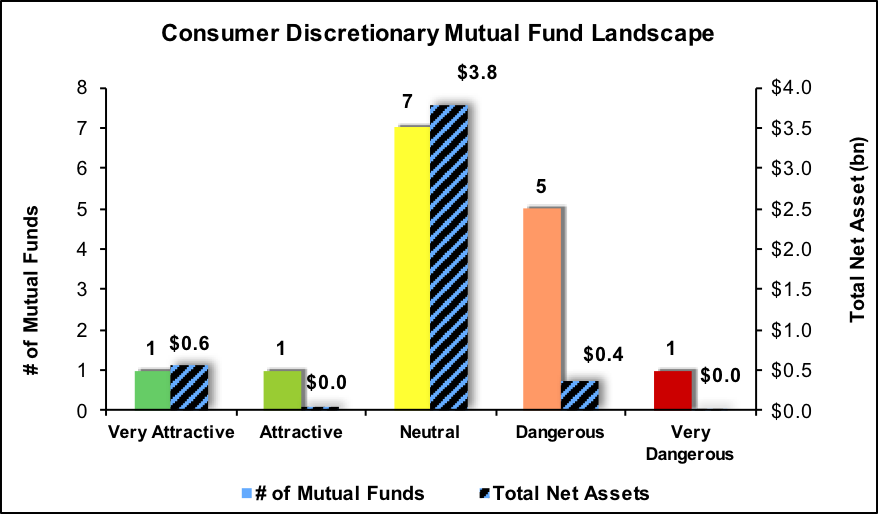The Consumer Discretionary sector ranks sixth out of the ten sectors as detailed in our 3Q17 Sector Ratings for ETFs and Mutual Funds report. Last quarter, the Consumer Discretionary sector ranked fifth. It gets our Neutral rating, which is based on an aggregation of ratings of 12 ETFs and 15 mutual funds in the Consumer Discretionary sector as of July 12, 2017. See a recap of our 2Q17 Sector Ratings here.
Figure 1 ranks from best to worst the seven Consumer Discretionary ETFs that meet our liquidity standards and Figure 2 shows the five best and worst-rated Consumer Discretionary mutual funds. Not all Consumer Discretionary sector ETFs and mutual funds are created the same. The number of holdings varies widely (from 25 to 378). This variation creates drastically different investment implications and, therefore, ratings.
Investors seeking exposure to the Consumer Discretionary sector should buy one of the Attractive-or-better rated ETFs or mutual funds from Figures 1 and 2.
Our Robo-Analyst technology empowers our unique ETF and mutual fund rating methodology, which leverages our rigorous analysis of each fund’s holdings. We think advisors and investors focused on prudent investment decisions should include analysis of fund holdings in their research process for ETFs and mutual funds.
Figure 1: ETFs with the Best & Worst Ratings

* Best ETFs exclude ETFs with TNAs less than $100 million for inadequate liquidity.
Sources: New Constructs, LLC and company filings
Guggenheim S&P 500 Equal Weight Consumer Discretionary ETF (NYSE:RCD), PowerShares S&P Small Cap Consumer Discretionary (NASDAQ:PSCD), PowerShares DWA Consumer Cyclicals Momentum (PEZ) and PowerShares Dynamic Retail (NYSE:PMR) are excluded from Figure 1 because their total net assets (TNA) are below $100 million and do not meet our liquidity minimums.
Figure 2: Mutual Funds with the Best & Worst Ratings – Top 5

* Best mutual funds exclude funds with TNAs less than $100 million for inadequate liquidity.
Sources: New Constructs, LLC and company filings
Rydex Leisure Fund (RYLIX) is excluded from Figure 2 because its total net assets (TNA) are below $100 million and do not meet our liquidity minimums.
PowerShares Dynamic Leisure & Entertainment (NYSE:PEJ) is the top-rated Consumer Discretionary ETF and Fidelity Select Leisure Portfolio (FDLSX) is the top-rated Consumer Discretionary mutual fund. Both earn a Very Attractive rating.
PowerShares Dynamic Media (NYSE:PBS) is the worst rated Consumer Discretionary ETF and ICON Consumer Discretionary Fund (ICCAX) is the worst rated Consumer Discretionary mutual fund. PBS earns a Neutral rating while ICCAX earns a Very Dangerous rating.
448 stocks of the 3000+ we cover are classified as Consumer Discretionary stocks.
The Danger Within
Buying a fund without analyzing its holdings is like buying a stock without analyzing its business and finances. Put another way, research on fund holdings is necessary due diligence because a fund’s performance is only as good as its holdings’ performance. Don’t just take our word for it, see what Barron’s says on this matter.
PERFORMANCE OF HOLDINGs = PERFORMANCE OF FUND
Analyzing each holding within funds is no small task. Technology may be the only solution to the dual mandate for research: cut costs and fulfill the fiduciary duty of care. Investors, clients, advisors and analysts deserve the latest in technology to get the diligence required to make prudent investment decisions.
Figures 3 and 4 show the rating landscape of all Consumer Discretionary ETFs and mutual funds.
Figure 3: Separating the Best ETFs From the Worst ETFs

Sources: New Constructs, LLC and company filings
Figure 4: Separating the Best Mutual Funds From the Worst Mutual Funds

Sources: New Constructs, LLC and company filings
Disclosure: David Trainer, Kenneth James and Kyle Guske II receive no compensation to write about any specific stock, sector or theme.
